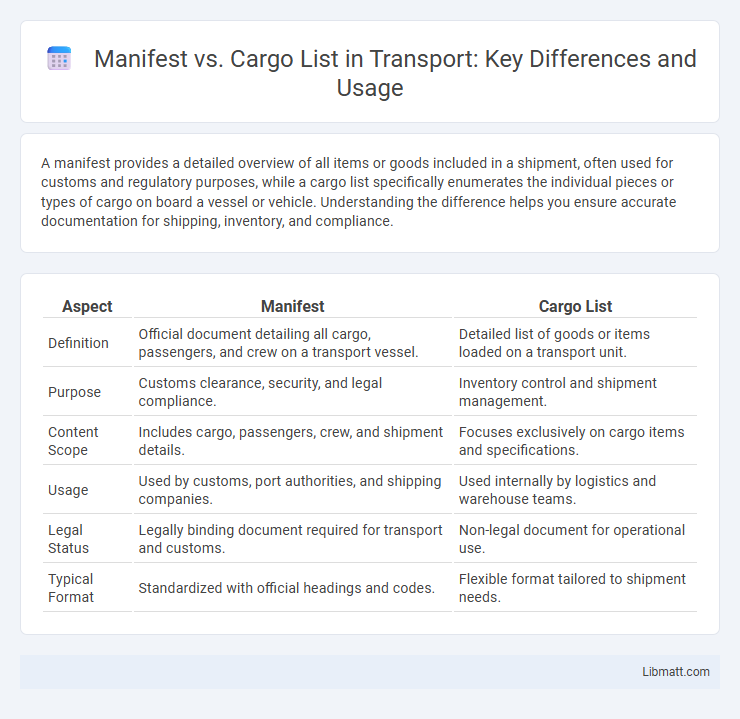A manifest provides a detailed overview of all items or goods included in a shipment, often used for customs and regulatory purposes, while a cargo list specifically enumerates the individual pieces or types of cargo on board a vessel or vehicle. Understanding the difference helps you ensure accurate documentation for shipping, inventory, and compliance.
Table of Comparison
| Aspect | Manifest | Cargo List |
|---|---|---|
| Definition | Official document detailing all cargo, passengers, and crew on a transport vessel. | Detailed list of goods or items loaded on a transport unit. |
| Purpose | Customs clearance, security, and legal compliance. | Inventory control and shipment management. |
| Content Scope | Includes cargo, passengers, crew, and shipment details. | Focuses exclusively on cargo items and specifications. |
| Usage | Used by customs, port authorities, and shipping companies. | Used internally by logistics and warehouse teams. |
| Legal Status | Legally binding document required for transport and customs. | Non-legal document for operational use. |
| Typical Format | Standardized with official headings and codes. | Flexible format tailored to shipment needs. |
Introduction to Manifest and Cargo List
A manifest is a comprehensive document detailing all cargo, passengers, and crew on a vessel, essential for customs and regulatory compliance. A cargo list specifically itemizes the goods being transported, including descriptions, quantities, and packaging details. Understanding the distinction helps you ensure accurate shipment documentation and smooth logistics management.
Definition of Manifest
A manifest is an official document listing all cargo, passengers, and crew on a vessel, airplane, or vehicle for transportation and customs purposes. It provides detailed information such as item descriptions, quantities, origins, and destinations to ensure regulatory compliance and facilitate shipment tracking. Your shipment's accurate manifest is essential for smooth logistics and avoiding delays during inspections.
Definition of Cargo List
A cargo list is a detailed inventory that itemizes every shipment or item contained within a vessel, vehicle, or container, specifying quantities, descriptions, and sometimes value. Unlike a manifest, which serves as a legal document outlining the entire shipment for regulatory and customs purposes, the cargo list provides precise details primarily for operational and logistical use. This document facilitates accurate tracking, inventory control, and ensures proper loading, unloading, and handling of goods during transit.
Key Differences Between Manifest and Cargo List
The manifest provides a comprehensive overview of all cargo, passengers, and crew aboard a vessel, while the cargo list specifically details only the goods being transported. A manifest includes essential data such as ship name, voyage number, and destination, whereas the cargo list focuses on item descriptions, quantities, and packaging details. Shipping companies and customs officials rely on the manifest for regulatory compliance, whereas the cargo list is primarily used for inventory management and logistical planning.
Purpose and Function of a Manifest
A manifest serves as a comprehensive document detailing all cargo, passengers, and crew on a vessel for regulatory, safety, and logistical purposes. It functions as an official record used by customs and port authorities to verify the contents and ensure compliance with legal requirements. Your ability to track shipments and facilitate smooth transportation heavily relies on the accurate preparation and use of the manifest.
Purpose and Function of a Cargo List
A cargo list serves as a detailed inventory of goods loaded on a vessel, itemizing each shipment with descriptions, quantities, and packaging details for efficient handling and verification. It ensures accurate tracking, facilitates customs clearance, and supports inventory management during transit. Unlike a manifest, which is a comprehensive document submitted to authorities for regulatory compliance, a cargo list primarily aids operational logistics and shipment accountability.
Legal Requirements and Compliance
A manifest serves as a comprehensive document required by customs authorities, listing detailed information about the entire shipment for legal compliance and border security. The cargo list, while similar, often functions as an internal record specifying contents and quantities for operational and inventory management, but does not fulfill all legal obligations. Ensuring accurate and timely submission of the manifest is crucial to meet regulatory standards, avoid penalties, and facilitate smooth customs clearance.
Usage in International Shipping
A manifest in international shipping serves as a comprehensive document detailing the entire shipment's contents, including all cargo, consignors, and consignees, which customs authorities use for clearance and regulatory compliance. The cargo list, by contrast, provides a detailed breakdown of individual items or packages within the shipment, aiding in accurate inventory management and shipment verification. Understanding the distinction between a manifest and a cargo list ensures your international shipping operations comply with legal requirements and optimize logistical efficiency.
Advantages and Limitations of Each Document
A manifest provides a comprehensive overview of all cargo on a vessel, facilitating customs clearance and ensuring regulatory compliance, but it may lack detailed item descriptions needed for precise inventory management. A cargo list offers granular details about each shipment, improving tracking accuracy and inventory control, yet it might be less effective for overall vessel documentation and customs processing. Understanding these differences helps optimize shipping operations by leveraging the manifest's broad regulatory role and the cargo list's detailed inventory advantages.
Conclusion: Choosing the Right Document
Selecting the right shipping document depends on the purpose and detail required for your cargo. A manifest provides a comprehensive summary of all shipments on a vessel or vehicle, while a cargo list offers a detailed itemization of individual goods. Ensure Your choice aligns with regulatory needs and operational efficiency for smooth logistics management.
manifest vs cargo list Infographic

 libmatt.com
libmatt.com